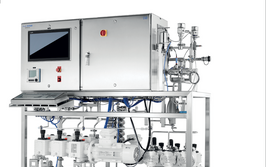A Winning Bid
Founded in 1998, Emergent BioSolutions has gone on to become a multinational biopharma company – despite working in some difficult therapeutic areas, including biodefense.
Tell us the story behind Emergent BioSolutions…
The company was founded in 1998 (we celebrated our 20th anniversary just a few months ago) by Fuad El-Hibri, who is our former CEO and now executive chairman. Essentially, the company came about from a winning bid for assets from the Michigan Department of Health and Human Services.
The Department had developed an anthrax vaccine back in the 1960s in collaboration with Michigan State – primarily for use by veterinarian and certain textile workers (anthrax is a ubiquitous soil microbe that is found on the fur, hair, and coatings of certain animals). It is also possible to isolate anthrax spores from spores from natural sources, which can be used as a bioweapon. When the site fell out of regulatory compliance, the state didn’t have enough resources to bring it back up to scratch. Instead they turned it into the Michigan Biologic Products Institute and put it up for bid, with El-Hibri being the winning bidder.
El-Hibri was really interested in the anthrax vaccine because he had worked with Porton Down in a prior life and was familiar with government needs for vaccines against bioterrorism agents. He saw an opportunity to build a company to provide products in a niche pharmaceutical area that traditional big pharma companies were ignoring because they didn’t see a viable business case.
We spent a few years getting the Michigan manufacturing facility back into regulatory compliance. These were difficult times because we weren’t selling, and the fact that we succeeded is testament to the creativity and perseverance of not only the founder, but also the senior management team at the time. We formed a number of collaborations with government agencies and established partnerships very early on to help us get through that period.
Today, we sell our anthrax BioThrax (Anthrax Vaccine Adsorbed) to the US Department of Health & Human Services where it’s primarily used for the strategic national stockpile. We also sell to friendly overseas governments.

What are the challenges of developing products for biodefense?
This is a very tough space in which to operate and build a business, but there is a vital need for these types of products for national security and public health. Before joining Emergent BioSolutions, I worked for 10 years in a classic biotech start up company and the business motivations and the drivers were significantly different. At Emergent, we have a prudent business philosophy and have used our profits to buy additional companies and assets in this space – and today we have a pretty extensive library of products.
Most vaccines are developed (and efficacies determined) in field studies with adults and paediatric patients. With anthrax and other potential bioweapons, such as nerve gas exposure, you can’t perform such studies because there aren’t enough natural cases out there. The FDA had to find a way to get these products approved, which led to the “Animal Rule.” FDA approval of such products is based on animal studies and companies have to be very creative in demonstrating efficacy in multiple animal models that mimic the human condition. There is a mouse model for everything out there but some are more predictive than others, and it takes a lot of effort to identify and work with collaborators in the government and at the FDA to agree on those animal models in addition to demonstrating safety, efficacy, pharmacokinetics and pharmacodynamics in humans.
How does developing medical countermeasures for bioterrorism compare with developing traditional therapeutics?
A lot of the skills, equipment and infrastructure are the same as for developing any other standard vaccine or therapeutic. The difference lies in the infectivity and classification of the agents you are developing your drugs and vaccines against. Take anthrax or smallpox for instance; these agents must be handled under highly controlled situations. Having the environments, facilities and trained individuals who know how to work with those agents is a necessity for this business space. If you are in a BSL3 or BSL4 laboratory there are absolute procedures that you must follow to safely handle and record usage of an organism. We really encourage our employees to think creatively around how to develop efficacious products that have the greatest utility under emergency conditions as well.
How do you collaborate with governments?
It is very important to build good collaborative relationships with different government agencies. You need to understand their needs but we’ve also needed to educate them about what we need from a business perspective so that we can be a long-term sustainable partner and collaborator for them. An example of that is multiyear contracting and ensuring that money is going to be available to procure these agents to keep stockpiling them to the levels that governments want to achieve.
We’ve worked with agencies like the US Defense Advanced Research Projects Agency (DARPA) to develop larger-capacity manufacturing capability for some of our products. We have a manufacturing facility in North Baltimore, which is a Center for Innovation in Advanced Development and Manufacturing (CIADM). We are actually a surge flu manufacturing site for the government in case there is a need for additional pandemic influenza vaccines.
What else is in your portfolio and pipeline (that you can tell us about)?
We are in the process of developing a new anthrax vaccine that includes an additional adjuvant. It will be a dual adjuvant anthrax vaccine that we have designed to potentially achieve immune protection faster than BioThrax. The immunization schedule for BioThrax is three doses. If approved by FDA, the labelled immunization schedule will likely be only two doses.
Aside from an anthrax vaccine, we have many other speciality products in our portfolio. Some of our products have been picked up from big pharma because they weren’t financially viable or interesting for those companies, based on traditional pharmaceutical business models. For example, we acquired a cell-based smallpox vaccine, ACAM2000, and a monoclonal antibody, raxibacumab, developed as a therapeutic aid for anthrax toxicity.
Recently, we acquired PaxVax, which gives us some interesting vaccine products that can be useful for both the commercial travellers’ market and for military use when troops deploy to certain areas where they might be exposed to cholera or typhoid fever. Only a few months ago, we also announced the acquisition of a European pharmaceutical company called ADAPT Pharma, which currently produces the only FDA approved needle-free emergency opioid overdose treatment.
We also have our Vaccinia Immune Globulin program; we collect plasma from individuals who have been vaccinated with our smallpox vaccine to generate anti-smallpox antibodies that can be used as a therapeutic for people who may have been, or might be exposed to, smallpox, but haven’t been vaccinated – it’s basically a rescue therapeutic. We also have a botulism antitoxin indicated for the treatment of symptomatic botulism following documented or suspected exposure to botulinum neurotoxin serotypes A, B, C, D, E, F, or G in adults and pediatric patients. The technology, which has been enhanced and modernized over the years, uses horses to generate a certain type of monoclonal antibody that we can use in humans to neutralize botulism toxin occurring either through intentional release or through contamination – perhaps from improperly processed seafood. Babies can also acquire infant botulism by eating unpasteurized honey that may be contaminated with botulism spores. We are hoping to use our Vaccinia Immune Globulin technology to create an influenza immune globulin product that treats complicated influenza cases, particularly in the elderly who don’t respond well to the flu vaccine and have a high mortality rate due to influenza. We’re looking to use the same technology for Zika too.
We also have some projects in the nerve agent chemical antidote space. We are trying to develop additional products using our auto injector technology but carrying different APIs to treat different types of chemical exposure. We’re also working with the US government on developing a nasal antidote for cyanide exposure.
We’ve also set up a new business focusing on devices (just under two years ago, we split the company into four business units: vaccines and anti-infectives, antibody therapeutics, devices, and contract development and manufacturing). For example, we have an auto-injector product for nerve agent antidote drug delivery and a reactive skin decontamination lotion kit that removes or neutralizes chemical warfare agents on the skin. We also have some surface decontamination products.
There is a great deal of satisfaction and reward with this work. While we started out 20 years ago as a biodefense company, through the years Emergent has expanded its focus to address public health threats outside of chemical and biological threats to include existing and emerging infectious diseases such as Ebola, Zika, influenza, typhoid, and cholera, as well as opioid overdoses. Building the business has come with challenges, but we take pride in the fact that we are helping to protect and enhance life – which is the company’s mission. Hopefully our vaccines will never need to be used outside of the military when troops are stationed in areas where bioweapons may have been developed in the past or may currently be deployable. But if ever they are needed, we want to ensure that civilians have access to safe, efficacious and quality vaccines and medical countermeasures.
Jim Jackson is Chief Scientific Officer at Emergent BioSolutions.


















